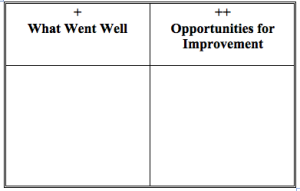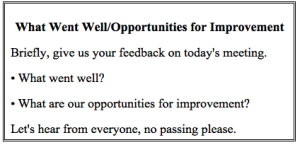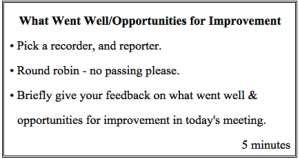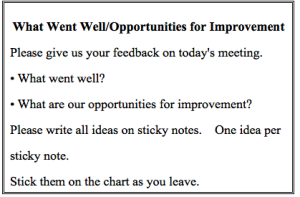As with any product or service, meetings need feedback from their customers (in this case participants) in order to continually increase their effectiveness. I plan to share four techniques that give meeting facilitators specific processes to obtain accurate information about the effectiveness of their meetings. These technique alternatives ask for different types of information in different ways, but all provide the meeting facilitator with the data necessary to accurately measure and consistently improve the quality of his or her meetings.
These four techniques include:
- What Went Well/Opportunities for Improvement
- Once Around the Table
- Team Effectiveness Chart
- Written Questions
Today, we’ll focus on Technique #1.
“I’ve been leading our team meetings now for almost a year but I’ve never asked for feedback on how I’m doing. Is there an accurate, fast, and easy way to get input from my group about how well our meetings are going?”
#1: What Went Well/Opportunities for Improvement
What is What Went Well/Opportunities for Improvement?
What Went Well/Opportunities for Improvement is a technique for gathering feedback on how well your meetings work. This type of technique, sometimes called a process check, is usually scheduled at the end of a meeting, but it can be used at any time you feel it is necessary.
The primary focus of the What Went Well/Opportunities for Improvement technique is to analyze the effectiveness of the processes and techniques that have been utilized in the specific meeting under consideration. This technique also gathers feedback on other aspects of the meeting, such as the quality of the content and results, participant behavior, and participation in general.
This type of feedback gives important information to the meeting facilitator. The information helps provide a basis for technique selection in subsequent meetings with the same meeting group, as well as challenges the facilitator to work consistently to improve the product he or she delivers.
When to Use What Went Well/Opportunities for Improvement
- When you want to receive honest feedback about the quality of your meetings
- When you want to improve the caliber of your meetings
- When you want meeting feedback to be open and shared by all
- When you want meeting feedback to be formally quantified instead of informal
How to Use What Went Well/Opportunities for Improvement
Before the Meeting:
- Put What Went Well/Opportunities for Improvement on the meeting agenda.
- Determine which option you want to use in your meeting. Variation 1 is designed to obtain verbal feedback from the whole meeting group, Variation 2 obtains this verbal information from small groups, and Variation 3 provides individual, written feedback. You may choose to use all of these variations with the same meeting group over time to keep them from tiring of the same technique.
NOTE: You will need to allot between five and twenty minutes for this exercise, depending on the size of your meeting group and the specific technique option you choose to use. Variation 1 should require ten to fifteen minutes, Variation 2 twenty minutes, and Variation 3 will take about five minutes.
- Prepare two charts, one that looks similar to the one illustrated below. Also include an instruction chart for the technique option you will use. Example charts for each option are also provided below.
NOTE: Some facilitators, when creating their What Went Well/Opportunities for Improvement chart, write a “+” at the top of one column for What Went Well and a “-” or “++” in the Opportunities for Improvement column.
During the Meeting:
- Introduce the What Went Well/Opportunities for Improvement technique. If this is the first time your group has used this technique, take a minute to describe the purpose, process and payoff of the exercise. You might say, for example, “The purpose of What Went Well/Opportunities for Improvement is to hear from each of you how you feel our meeting went today. I’d like to hear about both what you thought went well, or was effective, and what you thought didn’t go so well, where there are opportunities for improvement. Here’s how we will do it.” Display and explain your prepared instructions from Variations 1, 2, or 3 outlined below. Then you might say, for example, “The payoff of this exercise will hopefully be a better meeting the next time we meet. I plan to incorporate your ideas, building on what went well, and look for ways to capitalize on our opportunities for improvement.”
- Lead the exercise, using one of the three following options.
Variation 1: Obtain verbal feedback as a full group
This works well when your group is under 20 participants and you have about ten to fifteen minutes at the end of your meeting.
a) Explain the exercise to the group, using a chart similar to the one shown in Figure 9-2 as a visual aid. You might say, “In one or two brief sentences, tell us what you think went well and what you feel are our opportunities for improvement for this meeting.”
b) Ask for a volunteer in the group to begin. Suggest the round robin method (hearing from everyone in sequence) or popcorn method (anyone speaks up whenever they want, no specific sequence is required or expected) for listening to everyone’s comments.
NOTE: You could also ask for anyone who has feedback to bring it up when he or she is ready instead of asking everyone to participate. This is an especially good option when time is short or your group is large.
c) Document all comments on your prepared chart.
d) Debrief the information, and obtain agreement on what can be done differently for the next meeting.
NOTE: Consider going through each item on the “opportunities for improvement” side of the chart to help the group identify specific actions for the next meeting.
NOTE: Make sure that the sound of your voice supports your openness to questions and concerns. If your voice doesn’t support your words (due to sarcasm and defensiveness, for example) you will lose credibility.
Variation 2: Obtain verbal feedback from small groups
If your group includes over 20 participants, break your group into a few small work groups. Be sure that each group has an easel, chart paper and markers.
a) Explain the exercise to the groups, using a chart similar to the one below as a visual aid.
b) Give the groups five minutes to share and chart their feedback.
c) Ask each group for a two minute report back.
d) Debrief the information shared by each small group. To help the groups you might ask, “What are the commonalities?” “Which seem to be our strengths?” “Which areas should we concentrate on in order to make the greatest improvements?”
Variation 3: Obtain individual, written feedback
This option works well with small or large groups. Use it when you do not have or do not want to take time in the meeting for verbal feedback. The feedback can be reviewed at the next meeting or as part of the minutes of the meeting. This is an excellent feedback technique to use right before lunch in an all day meeting, where corrections and modifications can then be made in the afternoon.
a) Explain the exercise, using a visual aid like the one shown below. Be sure that there are enough sticky notes within reach of all participants.
b) Begin the exercise. Place the prepared chart paper and easel by the door so that it is easy for participants to quickly stick their feedback on the chart as they leave the meeting.
c) After the participants have left, read and cluster the feedback. Decide what actions are appropriate given the feedback from the group. Decide how to incorporate their ideas and how to communication your intentions, either as part of the minutes of the meeting, or at the beginning of the next meeting.
NOTE: If you use this option, give participants the results of the feedback when the meeting reconvenes, at the next meeting, or in the meeting minutes. It’s best to cluster like comments together, so you can say, for example, “Seven people made comments about the effectiveness of our brainstorming session,” before you read the comments verbatim. Be sure not to sugar-coat the results or you will lose credibility. Consider stating your action plan for improvement based on these comments.
In Summary:
What Went Well/Opportunities for Improvement is a technique for gathering feedback from meeting participants on the strengths and weaknesses of the meeting you just facilitated.
Before the Meeting:
- Put What Went Well/Opportunities for Improvement on the agenda.
- Determine ahead of time which of the variation you will use in your meeting. Variation 1 obtains verbal feedback from the full group, Variation 2 from small groups, and Variation 3 obtains individual, written feedback.
- Prepare the charts you will need to support you.
During the Meeting:
- Introduce the What Went Well/Opportunities for Improvement technique.
- Lead the exercise using one of the three following options.
Variation 1: Obtain verbal feedback as a full group
a) Explain the technique to the group.
b) Ask for a volunteer in the group to begin the exercise.
c) Document all comments on your prepared chart.
d) Debrief the information shared from each group, and obtain agreement on what can be done differently to improve the next meeting.
Variation 2: Verbal feedback in small groups
a) Explain the exercise to the small groups.
b) Give the small groups five minutes to share and chart their feedback.
c) Ask each group for a two minute report back.
d) Debrief the information shared from each group.
Variation 3: Individual, written feedback
a) Explain the exercise.
b) Begin the exercise, and place the prepared chart and easel by the door.
c) Read and cluster the feedback. Decide how to incorporate the ideas into your next meeting and how to communicate your intentions.
_______________________________
NOTE:
If you would like to receive e-mail notification when I post additional techniques, please sign up through this link. http://eepurl.com/KILan You may unsubscribe at any time.
You will find my book Mission Critical Meetings: 81 Practical Facilitation Techniques on Amazon. Your feedback and reviews are most welcome.




3 Responses to Four Techniques to Evaluate Meeting Effectiveness: #1 What Went Well/Opportunities for Improvement